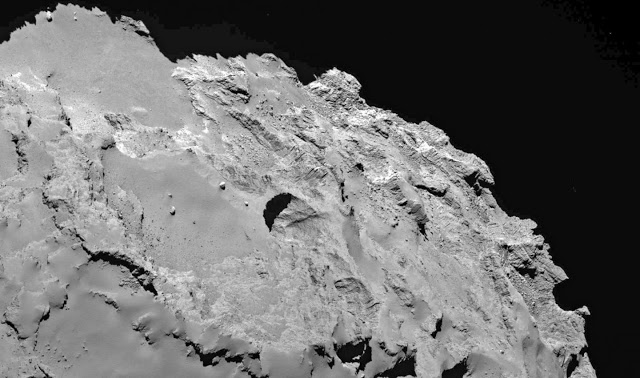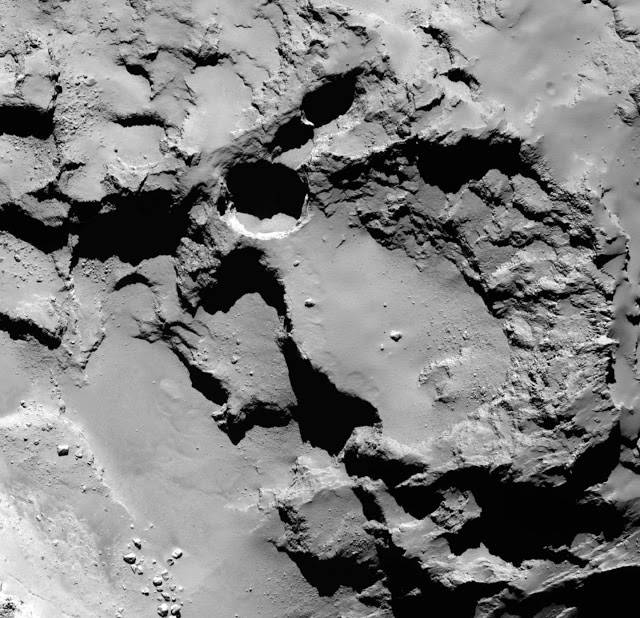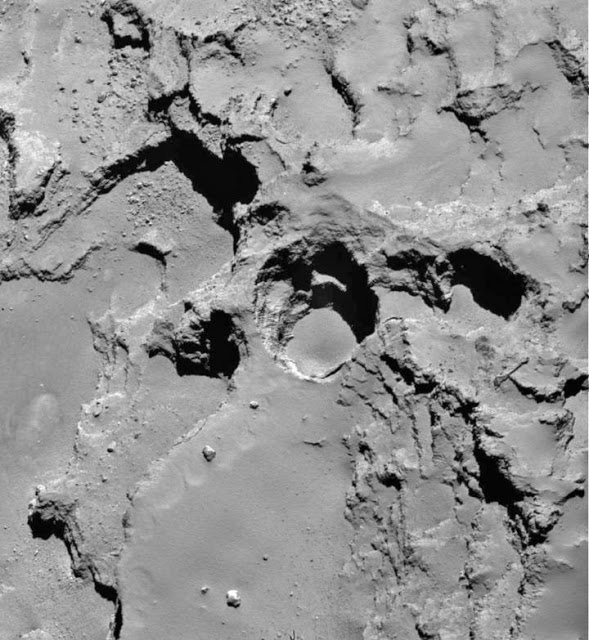| Online: | |
| Visits: | |
| Stories: |

| Story Views | |
| Now: | |
| Last Hour: | |
| Last 24 Hours: | |
| Total: | |
Sinkholes Discovered on Comet
The European Space Agency’s Rosetta spacecraft first began orbiting comet 67P/Churyumov-Gerasimenko in August 2014. Almost immediately, scientists began to wonder about several surprisingly deep, almost perfectly circular pits on the comet’s surface.
This close-up image shows the most active pit, known as Seth_01, observed on the surface of comet 67P/Churyumov-Gerasimenko by the Rosetta spacecraft. A new study suggests that this pit and others like it could be sinkholes, formed by a surface collapse process similar to the way these features form on Earth.

Credit: Vincent et al., Nature Publishing Group
Now, a new study based on close-up imagery taken by Rosetta suggests that these pits are sinkholes, formed when ices beneath the comet’s surface sublimate, or turn directly to gas.
This close-up image shows the most active pit, known as Seth_01, observed on the surface of comet 67P/Churyumov-Gerasimenko by the Rosetta spacecraft. A new study suggests that this pit and others like it could be sinkholes, formed by a surface collapse process similar to the way these features form on Earth.
This close-up image shows the most active pit, known as Seth_01, observed on the surface of comet 67P/Churyumov-Gerasimenko by the Rosetta spacecraft. A new study suggests that this pit and others like it could be sinkholes, formed by a surface collapse process similar to the way these features form on Earth.
Bodewits and his co-authors analyzed images from Rosetta’s Optical, Spectroscopic and Infrared Remote Imaging System (OSIRIS) narrow angle camera, which is designed to image the surface of the comet’s nucleus. The team noted two distinct types of pits: deep ones with steep sides and shallower pits that more closely resemble those seen on other comets, such as 9P/Tempel 1 and 81P/Wild. The team also observed that jets of gas and dust streamed from the sides of the deep, steep-sided pits –a phenomenon they did not see in the shallower pits.
Initially, the Rosetta team suspected that discrete, explosive events might be responsible for creating the deeper pits. Rosetta observed one such outburst during its approach to the comet, on April 30, 2014. Catching this event in the act allowed the team to quantify how much material had been ejected, and it quickly became obvious that the numbers just didn’t stack up. Explosive outbursts alone could not explain the formation of these giant pits.
“The amount of material from the outburst was large–about 100,000 kilograms–but this is small compared to the size of the comet and could only explain a hole a couple of meters in diameter,” Bodewits explained. “The pits we see are much larger. It seems that outbursts aren’t driving the process, but instead are one of the consequences.”
Based on the Rosetta observations, the team has proposed a model for the formation of these sinkholes. A source of heat beneath the comet’s surface causes ices (primarily water, carbon monoxide and carbon dioxide) to sublimate. The voids created by the loss of these ice chunks eventually grow large enough that their ceilings collapse under their own weight, giving rise to the deep, steep-sided circular pits seen on the surface of comet 67P/Churyumov-Gerasimenko.
The collapse exposes comet ices to sunlight for the first time, which causes the ice chunks to begin sublimating immediately. These deeper pits are therefore thought to be relatively young. Their shallower counterparts, on the other hand, are most likely older sinkholes with more thoroughly eroded sidewalls and bottoms that have been filled in by dust and ice chunks.
“In some sense, these deep sinkholes remind me of the crater excavated on comet Tempel I by the Deep Impact mission,” said Michael A’Hearn, a Distinguished University Professor Emeritus of astronomy at UMD and a co-author on the study. A’Hearn also served as principal investigator on the Deep Impact mission, which coincidentally celebrates its ten-year anniversary this summer. “The process is completely different, of course, but both allow us to achieve the same broad goal of being able to see deeper into a comet.”
The European Space Agency officially extended the Rosetta mission on June 23, 2015, meaning that the spacecraft will have the opportunity to track comet 67P/Churyumov-Gerasimenko for a much longer time period as it moves away from the sun. The comet will reach perihelion, or its closest point to the sun, on August 13, 2015. The extension expands the mission by nine months, from the planned end date of December 2015 to September 2016. The extra observational time will enable the team to see how the comet’s surface responds to decreasing solar radiation.
Contacts and sources:
The research paper, “Large heterogeneities in comet 67P as revealed by active pits from sinkhole collapse,” Jean-Baptiste Vincent, et al., was published in the July 2, 2015 issue of the journal Nature.
Source:





